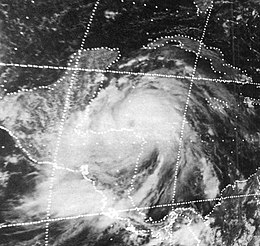Hurricane Fifi
| Category 2 hurricane (SSHWS/NWS) | |

Satellite image of Hurricane Fifi near the northern coast of Honduras
|
|
| Formed | September 14, 1974 |
|---|---|
| Dissipated | September 24, 1974 |
| Highest winds |
1-minute sustained: 110 mph (175 km/h) |
| Lowest pressure | 971 mbar (hPa); 28.67 inHg |
| Fatalities | At least 8,200 total |
| Damage | $1.8 billion (1974 USD) |
| Areas affected | Puerto Rico, Hispaniola, Jamaica, Nicaragua, Honduras, Belize, El Salvador, Guatemala, Mexico |
| Part of the 1974 Atlantic hurricane season and the 1974 Pacific hurricane season | |
Hurricane Fifi (later Hurricane Orlene) was a catastrophic tropical cyclone that killed between 3,000 and 10,000 people in Honduras in September 1974, ranking it as the fourth deadliest Atlantic hurricane on record. Originating from a strong tropical wave on September 14, the system steadily tracked west-northwestward through the eastern Caribbean. On September 16, the depression intensified into Tropical Storm Fifi just off the coast of Jamaica. The storm quickly intensified into a hurricane the following afternoon and attained its peak intensity on September 18 as a strong Category 2 hurricane. Maintaining hurricane intensity, Fifi brushed the northern coast of Honduras before making landfall in Belize the following day. The storm quickly weakened after landfall, becoming a depression late on September 20. Continuing westward, the former hurricane began to interact with another system in the eastern Pacific.
Early on September 22, Fifi re-attained tropical storm status before fully regenerating into a new tropical cyclone, Tropical Storm Orlene. Orlene storm traveled in an arced path toward Mexico while quickly intensifying into a Category 2 hurricane before landfall. The storm weakened after landfall and dissipated fully during the afternoon of September 24 over the mountains of Mexico. Along its path, Fifi impacted nine countries, leaving over 8,200 fatalities and $1.8 billion (1974 USD; $8.74 billion 2017 USD) in damages. Most of the loss of life and damage occurred in Honduras where rainfall from the hurricane, peaking around 24 in (610 mm), triggered widespread flash flooding and mudslides.
In a single town, between 2,000 and 5,000 people were killed overnight after a massive flood inundated the area. Fifi brought continuous rainfall to the area for three days, hampering relief efforts in what was the worst disaster in Honduras' history at the time. In nearby Guatemala, an additional 200 people were killed by severe flooding, making Fifi the worst hurricane to impact the country in nearly 20 years. Following the catastrophic damage wrought by the storm, relief agencies from around the world flew in emergency supplies to assist the hundreds of thousands of homeless people. Countries closer to Honduras, such as the United States, set up city donation centers that would send supplies to the country. In efforts to prevent the spread of post-storm diseases, the government allowed the burning of bodies as they were recovered. In a single day, up to 6,000 bodies were burned. Due to the extreme damage and loss of life, the name was retired from the list of Atlantic hurricane names and has not been used since.
...
Wikipedia
